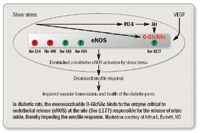Article
Origin, mechanism of diabetes-related erectile dysfuntion clarified
Baltimore--An oversupply of O-GlcNAc, a blood sugar present in hyperglycemic circumstances, is a major cause of diabetes-related erectile dysfunction, according to a new study by Johns Hopkins researchers published in the Proceedings of the National Academy of Sciences (2005; 102:11870-5).

In their efforts to clarify the mechanisms associated with diabetes-associated ED, scientists have looked at vascular aspects; specifically, at endothelial-derived nitric oxide, which is made by an enzyme called endothelial nitric oxide synthase (eNOS).

With this new understanding, scientists have been better able to recognize basic molecular factors within the penis that bring about erections and to determine that a prominent cause for diabetes-associate ED might involve impairment of the endothelial release of nitric oxide.
Finding the connection
Using rats as a model of diabetes and diabetes-associated ED, Dr. Burnett and colleagues were able to study the NO mechanism in diabetes. While they induced type 1 diabetes in the rats, Dr. Burnett said that whether they had induced type 1 or type 2 diabetes had little bearing.
"Whether it is type 1 or type 2, hyperglycemia occurs," he said. "We wanted to induce a model that we know is consistent with how diabetes occurs. But the final metabolic issue is that hyperglycemia is the consequence of diabetes, however it arises."
They found that, compared with controls, diabetic rats' erectile response was 30% lower, full erections were 40% smaller, and these erections took 70% longer to achieve.
"But, more importantly, this study clarifies the basis for endothelial nitric oxide being defective, showing that the diabetes state that causes this hyperglycemia and the component of this changed metabolism interact specifically with the chemical mechanism whereby endothelial nitric oxide does not get released," Dr. Burnett said.
According to Dr. Burnett, the glycosylation product O-GlcNAc binds to eNOS and inactivates the enzyme responsible for endothelial release.
eNOS, he said, has a basic biology that involves mechanisms on this enzyme that are responsible for its activation and inactivation, called phosphorylation sites. Ser-1177 is the most critical mechanism for how eNOS works to be functional to produce nitric oxide. The researchers also looked at eNOS phosphorylation at Thr-495, Ser-615, and Ser-633. They found that, while Thr-495, Ser-615, and Ser 633 were not affected, the study confirmed that eNOS phosphorylation at Ser-1177 was impaired in the diabetic rats.
"The clever observation here is that this monosaccharide O-GlcNAc happens to bind in this region, whereby this site cannot be phosphorylated like it should; therefore, eNOS is just not as active in diabetes," Dr. Burnett said.
Clinical impacts
The findings affect clinical urology practice in several ways, according to Dr. Burnett. The study reaffirms that the vascular system within the penis is critical for erections; in diabetes, eNOS is relevant, showing that this particular mechanism is altered; and it provides insight as to why phosphodiesterase type-5 inhibitors used to treat ED might not be effective in diabetic men.
2 Commerce Drive
Cranbury, NJ 08512
All rights reserved.





